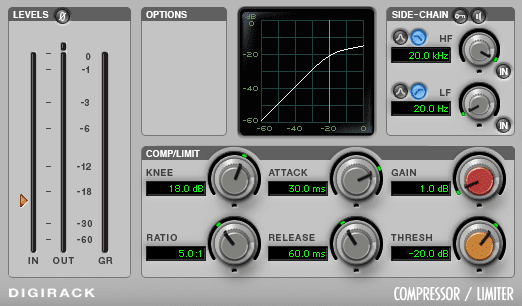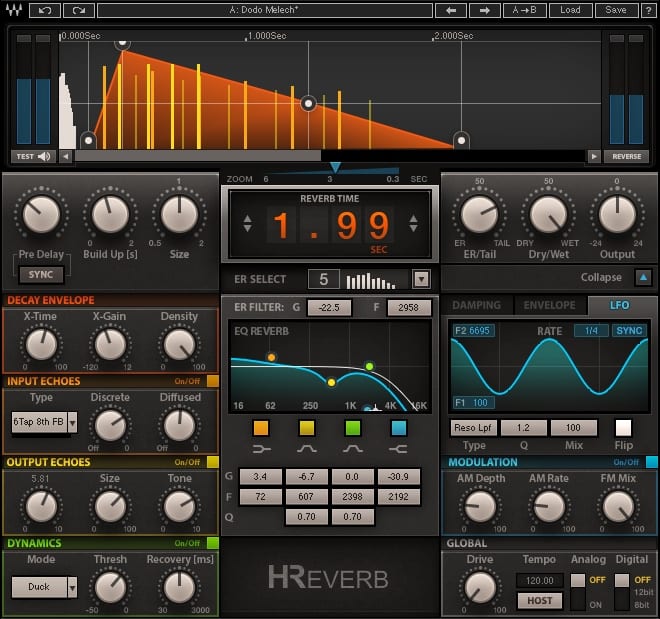We are all familiar with sidechaining in EDM music creating the “pumping” sound. While this is great creative use of sidechaining, there are countless other ways we can use sidechaining to mix tracks. These techniques can range from strictly functional to amazingly creative.
Let’s discuss the techniques to use within the sidechaining module itself. All compressors have very similar settings when switching to this mode. Many EDM engineers use similar settings that usually don’t vary much. To get the desired “pumping” sound they stick with a high ratio, quick attack, medium release time, and sharp knee to get the compressor to cut out 90%-100% of the signal. These settings are fine for this purpose, however, they can be manipulated in many other ways.
First off, ratio need not be so high to cut out so too much signal. For sidechaining, any sound could be desirable to have the signal only cut a small amount of level for a less intense effect. This can be done easily with a small changes to the ratio. Many songs use sidechaining for an immediate, large gain reduction, but there is still a lot that can be done with subtle settings. In many instances, it may more beneficial to cut less of the signal. The attack time could also be used more generously to help create space for whatever you are sidechaining, such as a synth motif, against a pad or just making the ducking less noticeable with a bass track. A longer attack time will sound much more like a fade rather than a short and hard cut. Similarly, a longer release time will sound like a long drawn-out build back to the original signal level rather than a quicker build. Furthermore, softer knee settings may lead to better results. It comes down to just experimenting with different settings to see what adds most value to the mix as a whole. A very powerful setting in sidechaining is the lowpass/highpass settings. These settings can be especially useful in a situation where you may want to cut-out the low or high-end of a signal in the sidechain. For example, cutting the low-end from a kick when the 808 kick hits, may be a quick and easy way to maintain the balance of low-frequencies in the mix while keeping the transient of the kick drum in-tact. Sidechaining a snare against an impact sound effect to maintain the low-end punch while temporarily cutting the highs from the snare drum would be an effective use of the low pass function. We will dive deeper into some uses for these as we touch on other useful sidechaining techniques.

There is the obvious, common use for sidechaining as we mentioned earlier between the kick and the bass. This technique can be used for creative purposes, but also for obtaining a cleaner mix. This technique simply takes the kick and the bass and puts them in the same area of the frequency spectrum, but ducks the audio of the bass so it is not in the way of the kick. Realistically, this doesn’t need to be done so the bass completely disappears (unless the root of the bass is that low) when the kick hits. This can be done in a much more subtle way. Better yet, this can be done to give the impression that the bass doesn’t decrease in volume while still clearing up the mix. As we mentioned before the highpass function can be used here to cut out some of the lows of the bass that are getting in the way of the kick. This can be done so that the bass comes back very quickly after the threshold of the kick passes and can give the impression that they coexist without any problems. Let’s say that you actually do want the dramatic “infinitely sidechained” effect. This is quite easy to employ but a tip while using this is to have the bass level rise back to its original level in-time. So whether you want the bass to come back up in an eighth note or a half note you can use this calculator to figure it out!
The equation the table uses is 60,000 ms (one minute) divided by your bpm. The result is the amount of milliseconds it takes for one beat.
An example would be:
(ms) (bpm) (¼ note)
60,000 / 140 = 429 ms
This is a great way to take your mix to the next level and make it sound more unified.
Many engineers find that sidechaining elements of drum tracks can make them sound full and intense. A common way to sidechain drums in hard rock and metal tracks is to sidechain the snare against the cymbals. This is so the high-end crack of the snare sticks out when it hits, but the cymbals will take some of that space back when the snare drum isn’t playing. Employing this method can also be used in other situations like sidechaining a snare against a busy percussion loop to keep the drive of the loop and maintaining the most important drums up front. In these two examples a low-pass function could also be used in keeping the loop playing while excluding a small part of the frequency spectrum. If the percussion loop has more low frequency elements it could also be used with a high-pass to filter out some low frequencies when the kick plays.

Drums for your songs may be the focal point, but many tracks probably have vocals that take precedence. Sidechaining vocals against delay and reverb may be a beneficial tool to use in a busy track to clear the fog of these effects, but maintaining their level when the vocal isn’t playing. Setting up a bus with these effects and putting a compressor on the track to sidechain the vocals. The difference can be large or small depending on what your track needs. For EDM tracks it is more useful to have a larger difference. Something can also be said about the great tool of only sidechaining delay. In most cases, delay on a track shouldn’t be used heavily while the vocal is playing. The compressor does its’ job well when it lets the delay go back up after the vocal is finished. A great example of this is Rihanna’s “Selfish”.
Sidechaining with vocals can also help when using them against background vocals. Instead of automating volume every time the main vocals come in, a sidechain can do this quickly by bussing the background vocals together with a relatively quick attack and slow release. You can take this a step further and sidechain the vocals against similarly ranged instruments like a melody line or perhaps strings.There may be a large group of instruments that could be eating up the space for the vocals and it might be more effective to create room this way. Maybe this tool could be used by sidechaining everything ! Simply put all the tracks together in one bus except vocals and apply sidechaining. These techniques can be extremely useful but still ultimately will rely on your ear to make decisions.
The main use of this effect is to basically make room for things that matter most in a mix. This is still the goal and sidechaining can be of use in instrumental tracks too! As we stated above, sidechaining similarly ranged parts can be a great way to take a melody line or an accentual synth line and making it the focus when other background parts may be playing under it. When finding room in the EQ spectrum for many instruments of similar range, it can be difficult at times, especially when it takes up the main synth line or melody space. In this instance it may be a great idea to simply sidechain the range of frequencies that will mostly affect the balance of these tracks against the main focus. Some multiband compressors with sidechain capabilities can really help this area of your mix. Along a similar vein, some tracks have multiple bass lines that will play at the same time but still need their low end when they play separately. While this may be uncommon, it is still useful to keep in mind as a possibility when dealing with low end tracks.
We touched on, in the vocals section, how effects can often get in the way of the main focus and the cleanliness of the mix. In the same way, effects can get in the way of instrumentals. A mixture of long, medium, short, and room reverbs and quarter, dotted eighth, and eighth delays among others can certainly confuse the mix. If it is destroying the mix but you feel it is absolutely necessary to have as many effects as you do, sidechaining could help. You may end up finding it is better to actually sidechain a bus of certain instrumental tracks against a bus of all the reverb and delay tracks. Obviously this won’t make a huge difference if used for all tracks, but may do well for a number of tracks that don’t play the whole time or have long attack and release times. A favorite reverb of mine is the H-Reverb because it already has this “duck” function within the module. Sidechaining can be the answer to making room on a more detailed level than just drums and vocals.

Sidechain compression may be an afterthought for many people, but it really packs a punch when it comes down to really perfecting a mix. Using sidechaining with every element of a track like drums, bass, vocals, synths, guitars, and effects, may be critical to a song’s success! It isn’t just for classic EDM tracks, it’s for all tracks in every way!
There are 8 unique value-points inside the Sage Audio membership, so let’s go over each one so you can decide if it’s the right fit for you.
1. 50 Free Mastered Songs Per Year
2. 1-on-1 Mentorship
3. Unlimited Mixing Feedback
4. Sage Audio University™ (SAU) — (Mixing and Mastering Education Platform)
5. Mixing and Mastering Competitions
6. Community
7. 70+ GB of Curated Sage Audio Downloadable Content, Including:
8. 700+ Video Catalog